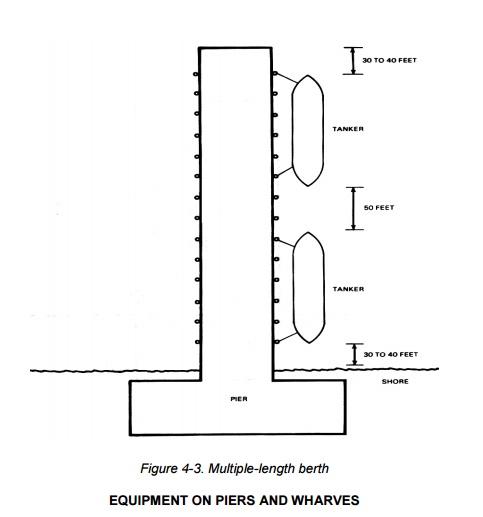Chapter: Civil : Railway Airport Harbour Engineering : Harbour Engineering
harbors: Loading and Unloading Facilities
Loading
and Unloading Facilities
PIERS AND WHARVES
Piers
and wharves are permanent structures built in protected harbors. They are built
using timber, concrete, or steel. Petroleum base terminals in developed
theaters have piers (Figure 4-1) or wharves equipped to load and unload tankers
and barges. Piers or wharves may have single-length berths or multiple-length
berths. A single-length berth (Figure 4-2) is 60 to 80 feet longer than the
largest tanker that uses it. A multiple-length berth (Figure 4-3) should be 110
to 130 feet longer than the combined lengths of the largest tankers that use
it. No vessel should be allowed to dock or moor within 50 feet of a vessel that
is unloading bulk cargo, unless the depot officer or supervisor and the master
of the vessel transferring cargo agree.



Figure
4-3. Multiple-length berth
EQUIPMENT
ON PIERS AND WHARVES
Piers and wharves at
base terminals are equipped with ship-to-shore hoselines; standard 4-, 6-, 8-,
or 12-inch pipelines; a loading and unloading manifold; valves; and fittings.
Booster pump stations are installed where needed. Each facility should have at
least one ballast tank with separate pipelines to receive and discharge water
and an oil and water separator to remove product from ballast water during a
transfer. A supply of water (preferably fresh water) and fire-fighting
equipment must be available at all times. The equipment should include fire
hoses, foam generators, and foam and carbon dioxide fire extinguishers. If
there is a source of steam, it can be used to fight a fire in a confined space,
such as a tanker compartment. Also, all piers and wharves must have the proper
grounding connections for fuel transfer operations.
TEMPORARY
STRUCTURES
Existing loading and unloading facilities in a
developed theater may also require self-elevating piers and pipeline jetties.
These are available through the Army Facilities Components System described in TMs 5-301-1, 5-301-2, 5-301- 3, and
5-301-4. The self-elevating pier
and pipeline jetty are described below.
Self-Elevating
Pier
A self-elevating pier (Figure 4-4) is a steel barge
which must be towed into place. It has jacks, caissons, and machinery that
raise the pier above the water to form a working platform. Depending upon
navigable conditions at the erection site, self-elevating pier may be employed
as single piers butted against a beach or as finger, marginal, T-head, or
L-head piers. TM 55-500 discusses this pier in
detail.

Figure
4-4. Self-elevating pier
Pipeline
Jetty
A pipeline jetty (Figure 4-5) is a structure made of
pilings and timber that extends as far as 1,000 feet from the shore. It is only
wide enough to support pipelines and to provide a walkway with a 40- by 70-foot
working platform at the tanker end. The pipeline jetties are used in protected
harbors to transfer fuel.

Figure
4-5. Pipeline jetty
TACTICAL
PETROLEUM TERMINAL
The TPT is the Army's
bulk-fuel storage facility. It is a fuel-handling system designed to receive,
store, and issue bulk petroleum fuels, specifically diesel fuel and jet fuels.
The TPT serves as a base terminal in an undeveloped theater and can be used in
the developed theater to supplement existing facilities that are inadequate or
damaged. For more information see Chapter 6.
OFFSHORE
PETROLEUM DISCHARGE SYSTEM
Related Topics